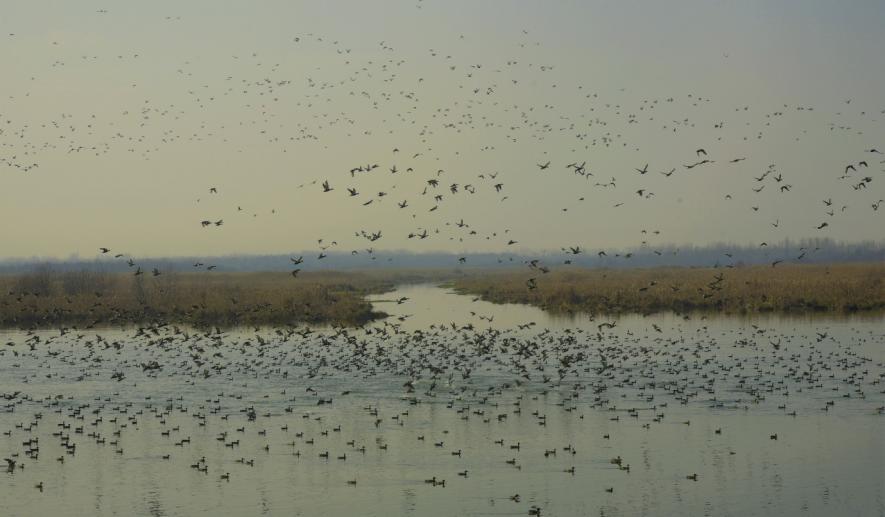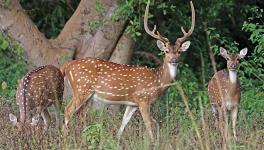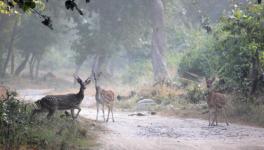Migratory Birds Flock to Kashmir Despite Shrinking Space, Poaching

An estimated 1 lakh migratory birds have already arrived at the Hokersar wetland, outside Srinagar, this year so far. Picture credit: Khalid Khan.
Srinagar: The December chill ends most of the excitement in Kashmir. A few remaining leaves cling to the mighty chinars, which can be spotted from a distance due to the rusty orange hue on an otherwise dull, hazy winter day. It is also the time when scores of bird species from Central Asia, China and places as far as Siberia and eastern Europe migrate to Kashmir.
Treated as winter guests by many and as a game by others in the next five months, migratory birds have been coming to the Valley for as long as one can remember. They stay for a while mostly near lakes, marshes and wetlands. An estimated 1 lakh birds have already arrived at the Hokersar wetland, outside Srinagar, this year so far.
This is the first time in the last two years that the ‘guests’ have found some good spots to stay. Shrinking space and the threat of poachers are a big concern but department of wildlife protection officials believe that a record number of birds will arrive this year.
“We have created an integrated management action plan for the restoration of all eight wetlands in our jurisdiction. In Hokersar, we have employed machinery, including water master and excavators, and have restored some (water) channels,” wildlife warden Ifshan Dewan tells Newsclick.
The wildlife department conducts a census of these migratory birds every year in February. More than 11 lakh birds visited the region in 2021 and 8.13 lakh of 39 species in 2020, according to the department data.
Some of the key birds which arrive in significant numbers and stay for about five months include Mallard, Common Teal, Northern Pintail, Common Coot, Northern Shoveler, Greylag Goose, Gadwall and Eurasian Wigeon.
Often, more than half of these birds are spotted in Hokersar, a wetland of about 13.55 sq km. According to the department, it is a safe roosting and feeding ground for migratory birds. The wetland also acts as a breeding and nesting ground for both migratory and resident birds.

Reyan Sofi, a popular birder from Srinagar, has campaigned hard for the restoration of the Hokersar wetland. Picture credit: Umer Asif.
Dredging, however, has been distracting the discreet birds, looking for food and silence in the wetland. Reyan Sofi, a popular birder from Srinagar, lives close to the wetland in Zainakote. The 27-year-old has campaigned hard for the restoration of the wetland. “If the birds are distracted and disturbed, they often leave the spot and it is very difficult to spot them again,” he says.
Dewan adds that the department has been working on other parts of the wetland submerged after more than 30-40 years. “We cannot completely stop the noise but ultimately it is important for the restoration of the wetland. We are also making sure that they do not get disturbed.”
Reyan has spotted 285 species of birds, some of them very rare, including the Sharp Tailed Sandpiper, for the first time in more than 100 years. He is also part of the local wildlife conservation initiative called Save Hokersar. “The past few years were too bad, which affected the migration of birds. The situation will not change if the wetland is not completely restored,” he adds.
Climate change and rampant urbanisation, according to wildlife officials and environmentalists, are threatening lakes and wetlands for migratory birds. Besides, poachers are another major challenge.
Hokersar was declared a game reserve in 1945 and remained a key hunting ground for the next five decades until it was banned. It was designated as a conservation reserve in 2002 and was later listed as an important bird area on the basis of its great ecological value. There has been a decline in poaching, according to range officer Sajid Farooq.
The department recently seized two double-barrel guns from poachers. Last year, as many as 30 guns, including a rifle worth more than Rs 5 lakh, were seized. “The licences for these guns were issued for personal safety but they were being used by poachers,” Farooq says.
Get the latest reports & analysis with people's perspective on Protests, movements & deep analytical videos, discussions of the current affairs in your Telegram app. Subscribe to NewsClick's Telegram channel & get Real-Time updates on stories, as they get published on our website.


















